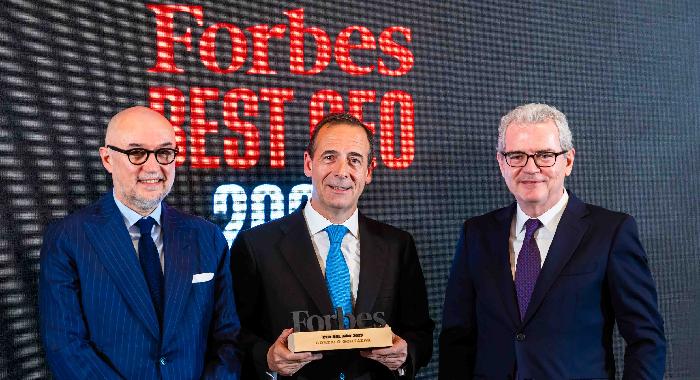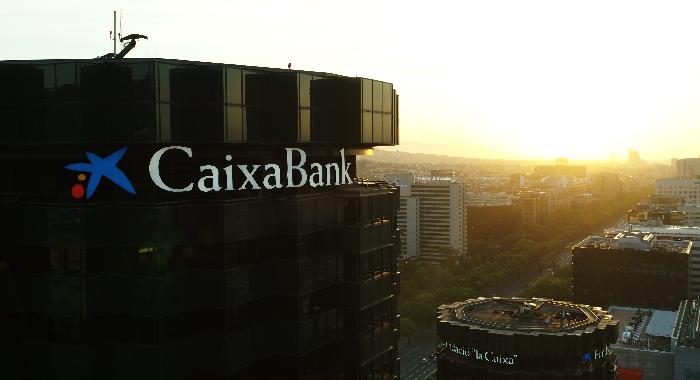The CaixaBank Group, with Jordi Gual as Chairman and Gonzalo Gortázar as CEO, reported a net attributable profit of €1.7 billion in 2019, down 14.1% year-on-year. The Group’s earnings were up 20.4% year-on-year to reach €2.4 billion, excluding the impact of the labour agreement reached in the second quarter, which generated a gross expense of €978 million (€685 million, net). Excluding this impact, ROTE would be up to 10.8%.
The contribution made by each business line to total Group earnings was as follows: banking and insurance (€1.06 billion); equity investments (€313 million); and BPI (€332 million).
With a customer base of 13.7 million in Spain, CaixaBank is the main bank for one out of every four retail customers. The Bank’s customer-facing model is focused on customer loyalty, strong commercial activity, innovation and a single omni-channel distribution platform to attain solid market shares across all main products and services, including direct payroll deposits, long-term savings products, mutual funds, pension plans, life insurance and business lending. CaixaBank has also cemented its leadership in digital banking, with a total of 6.5 million digital customers.
Core revenues totalled €8.3 billion in 2019 (+1.2%), showing further growth in the second half of the year and strengthening total earnings figures. Net interest income rose to €4.9 billion (+0.9% on 2018), largely as a result of additional interest income as total loans continue to increase, as well as the savings made in retail and institutional financing and a healthier contribution from the insurance business.
Meanwhile, fee and commission income amounted to €2.6 billion, up 0.6% on 2018 as well as up on the third quarter of 2019 (+5.7%) and on the same quarter of 2018 (+7.5%).
Dividend income in the second quarter of both years included the Telefónica dividend of €104 million. The second quarter of 2019 also included €46 million in dividend income from BFA. The fourth quarter of 2018 included a dividend of €23 million from the Bank’s remaining stake in Repsol at that time.
Meanwhile, the fourth quarter of 2019 included the contribution of €242 million made to the Deposit Guarantee Fund (€228 million in 2018). The second quarter included the contribution of €103 million to the Single Resolution Fund (€97 million in 2018). The period also saw a heavy reduction in expenses related to real estate assets following the sale of the real estate business in the fourth quarter of 2018.
As a result, gross income totalled €8.6 billion. The change in gross income (-1.8%) was largely down to the reduction in income from associates (-48.5%), since earnings from Repsol and BFA are no longer included. If we exclude the contribution made by Repsol and BFA, gross income would be up 3%.
Gains/(losses) on disposal of assets were down 77.3% year on year, largely due to a series of extraordinary events that took place in 2018, such as the recognition of losses incurred on the sale of the stake in Repsol and the losses generated from the change in accounting classification of the stake in BFA.
Drivers identified in the Strategic Plan are generating revenue growth
CaixaBank is making rapid progress in its ongoing transformation by strengthening its customer-oriented approach and planning to have over 600 ‘Store’ branches open by June 2020. It also remains firmly committed to local communities and financial inclusion, as illustrated by its presence in over 2,000 towns and cities and its deployment of new digital relationship models, including inTouch.
The main growth drivers under CaixaBank’s 2019-2021 Strategic Plan include long-term savings products, consumer finance and business lending, payment methods and insurance, all of which have been performing well.
Total loans and deposits gained 4.7% in the year to reach €611.7 billion. Intensive commercial efforts at the Bank also yielded growth in long-term savings products, pushing up its market share to 22.5%.
Customer funds totalled €384.3 billion in 2019 (+6.9%), thanks to the strength of the Bank and ongoing market recovery, with quarterly growth of 0.5%.
Highlights here included an increase in liabilities under insurance contracts (+7.5% in the year and +2.4% in the quarter), thanks to a healthy product portfolio performance and the Bank’s ability to adapt to customer needs. Unit Linked products also fared well, growing 35.3% in the year and 10.2% in the quarter.
Demand deposits grew to €189.6 billion (+8.8% in 2019). The quarterly change (+0.7%) was down to seasonal impacts within the retail segment, among other elements.
Assets under management rose to €102.3 billion. The annual performance (+8.9%) was largely down to steady market recovery following the slump seen at the end of the fourth quarter of 2018.
Within this same category, assets under management in mutual funds, portfolios and SICAVs amounted to €68.6 billion (+6.3% in the year and +2.2% in the quarter), while pension plans totalled €33.73 billion (+14.7% in the year and +3.7% in the quarter). CaixaBank has cemented its leadership in these businesses, holding a market share of 17.1% and 25.5% for mutual funds and pension plans, respectively.
Gross loans and advances to customers stood at €227.4 billion (+1.2% in the year), while the performing portfolio gained 2.4% in 2019, with business lending outperforming. Total loans to businesses (excluding real estate developers) were up 7.2% in 2019 (+2% in the quarter). The total market share of business loans comes to 15.1%.
Loans for home purchases (-3.5% in the year and -1.1% in the quarter) continue to feel the effects of ongoing household deleveraging processes and the seasonal effect of end-of-year loan repayments in the fourth quarter. Loans to individuals excluding residential mortgages were up 1.3% in 2019, on the back of strong consumer lending activity (+13.8%).
Non-performing loans down in response to sound risk management
NPLs were down €2.4 billion in the year (-€1.16 billion in the quarter). The NPL ratio was 3.6% at year-end (-108 basis points in 2019), an all-time low for CaixaBank. This improvement was down to the active management of non-performing assets and the gradual normalisation of asset quality indicators, supported by sales of non-performing loan portfolios throughout 2019, particularly in the latter stages of the year. The coverage ratio climbed to 55% (+1 percentage point in the year).
The portfolio of net foreclosed real estate assets available for sale in Spain amounted to €958 million (+€218 million in the year and +€44 million in the quarter). The portfolio of Spanish rental real estate assets stood at €2.1 billion, net of provisions (-€385 million in the year and -€141 million in the quarter), while total sales of real estate assets in 2019 came to €581 million. The cost of risk (12 months) was 0.15%.
Solid liquidity and capital
The Common Equity Tier 1 (CET1) ratio was 12% at 31 December. Excluding the extraordinary impacts seen in the first quarter, the ratio gained 37 basis points in the year from organic capital generation (+19 basis points in the quarter) and a further 31 basis points from the positive performance of the market and other impacts (+18 basis points in the quarter, which included new accounting rules for certain defined benefit commitments for employees).
This strong capital position provides a solid base for achieving the capital objective envisioned in the 2019-2021 Strategic Plan of around 12% plus a further buffer of one percentage point, which will be gradually built up by the end of 2021 to cover possible future regulatory changes, notably completion of the Basel III framework.
As for the MREL requirement (22.5% of RWAs at a consolidated level as of 1 January 2021), CaixaBank had an MREL ratio of 21.9% at 31 December 2019, including all liabilities currently classified as eligible by the Single Resolution Board. Calculated pro-forma to include the January 2020 debt issuance, the MREL ratio would already meet the required level of 22.5%.
Meanwhile, total liquid assets came to €89.4 billion at 31 December 2019, up €9.9 billion in the year thanks to the positive performance of the commercial funding gap and the fact that new issuances have outpaced maturities.
The balance drawn under the ECB facility was down to €12.9 billion at 31 December 2019, of which €3.9 billion related to TLTRO II and €9.03 billion to TLTRO III. In 2019, a total of €24.3 billion was repaid under TLTRO II, while €9.03 billion was drawn under TLTRO III.
The Group’s average Liquidity Coverage Ratio (LCR) was 186% at 31 December 2019, well above the minimum requirement of 100%.






